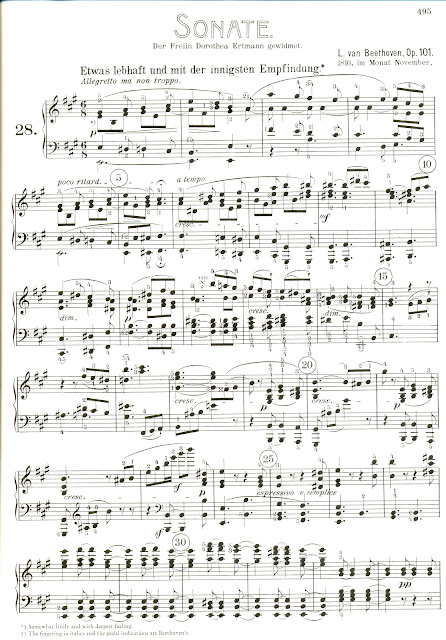 |
| Click to enlarge |
The movement is in A major, but the harmony of the beginning is E major. It is not so unusual for Beethoven to begin on the dominant--we just saw this in the last sonata. But it is unusual to avoid a cadence on the tonic so thoroughly. In fact the tonic A major only appears in passing, on weak beats, while on all the strong beats we have the dominant, E major, submediant, F# minor and mediant, C# minor. Every cadence is on the dominant. This goes on for not only this page, but the next as well. It is not until the movement is drawing to an end on the third page that we have cadences on the tonic. First, in measure 72, a very weak one to a first inversion tonic, followed by confirmation with a full cadence in mm 74 to 75. And from then to the final measure, 101, it is all decorated tonic. This whole movement is like a gigantic V - I cadence with the first two-thirds being dominant. But because of the strong harmonic conventions of the time we always know that A major is the tonic because the other harmonies are never treated like a tonic. The whole movement seems to hover in the air. Let's have a listen. This is Sviatoslav Richter in concert in 1986. Note that this clip has the first and the second movement. If you want, just stop it at the end of the first movement, about the 4:30 mark, and read on...
As if to compensate for the first movement being so suspended in air, the second movement is a very grounded march in F major with solid tonic to dominant in the first strain. The second begins with a typical relative minor (D minor) but, since this is Beethoven, wanders into F minor as well. Marches, like minuets, are usually paired with a contrasting movement called a trio. This dates from the 17th century practice of Lully, who would typically score the contrasting section for three instruments such as two oboes and bassoon. The name stuck, even when for a solo instrument. This trio is canonic, meaning that the voices imitate one another rather strictly, but also very graceful and delicate--a perfect foil for the march, which then returns, this time without repeats. Here is the score for the first page of the march:
 |
| Click to enlarge |
Now go back and listen to the march, from 4:30 in the clip. The next movement is slow, marked Langsam und sehnsuchtsvoll (slow and full of yearning), but it is very brief and seems to be just a slow introduction to the last movement. The style is Beethoven's patented blend of hymn with Baroque ornamentation, owing quite a lot to Bach. The key is A minor. Very surprisingly, though, it does not lead directly to a final, fast movement, but rather to a return of the first movement! This quotation is like a regretful memory that recalls another time (as, by this point, we are beginning to forget the first movement). Soon, the recall becomes energized and, with a series of trills, leads into the last movement proper. Here is the slow section:
 |
| Click to enlarge |
 |
| Click to enlarge |
The last movement is an elaborate sonata form with fugal elements, which Beethoven was incorporating more and more at this point. That opening motto with the falling 5th followed by a short scale fragment, is immediately echoed in the other voice. The rhythm will be preserved, but the motto itself will be heard with different intervals: 4ths, 3rds and 2nds. In the development the theme, usually with a falling 3rd, is used for a full-blown fugue. The prevailing mood of this movement with its restless energy and contrapuntal tricks and rhythmic twists is one of -- humor! Let's listen to these last two movements together as they are not meant to be separated:
By this time in his life, each of the important pieces by Beethoven is like a universe of its own. Each one seems to have its own personality, environment and rules. And each benefits from many listenings. Like Bach, I really don't think you can get tired of Beethoven.




0 comments:
Post a Comment